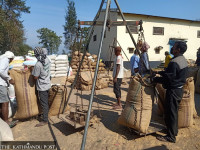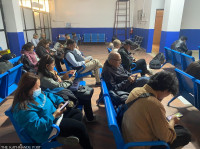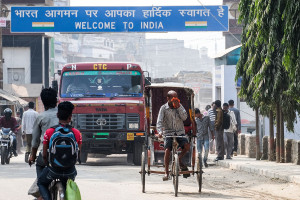Money
33k households in Baitadi off the grid
Only 12,000 out of the 45,000 households in Baitadi district have access to electricity. The remaining 33,000 households in this remote district in Province 7 in the country’s far west have to depend on solar power or kerosene lamps to light their homes.
Only 12,000 out of the 45,000 households in Baitadi district have access to electricity. The remaining 33,000 households in this remote district in Province 7 in the country’s far west have to depend on solar power or kerosene lamps to light their homes.
The district headquarters was connected to the national grid three decades ago, but only 30 percent of the households have access to electricity. In 1985, the district headquarters was connected with 11 kV feeders to import power from India.
Five years later, a 200 kW micro hydropower plant started producing electricity in Baitadi. In 2000, a 33 kV transmission line was installed to supply Baitadi with power. According to statistics, 33,000 out of the total 45,000 households in Baitadi lack access to electricity. At least 3,000 households have partial access to energy generated by the micro hydro. The 8 MW Api hydro project has also been producing energy in the district.
Recently, the 30 MW Chameliya Hydropower Project started generating energy. Despite the development, a large section of the population cannot get electricity. Even households near the power station have not received electricity.
“Electricity poles were erected a long time ago, but power lines have not been installed, and many villages lie in darkness,” said Chakra Bahadur Chand, a local of Patan Municipality.
The Nepal Electricity Authority office in Baitadi said that the budget allocation for the district for rural electrification was inadequate, and as a result, many parts of the district lack electricity access.
“At least Rs5 billion will be required to electrify the villages. The project can be completed within three years,” said Mahananda Joshi, a technician at the district electricity dispatch centre. The daily work of the rural municipality and ward officers has been affected due to lack of power.
Some micro hydropower projects in the district have been shut down due to the lack of financial problem to repair them. “The closure of micro hydro projects has largely affected small enterprises and economic activities in the villages,” said Ganesh Dutta Joshi, a local of Puchaudi Municipality. The lack of electricity access has also deprived people from banking access.
According to the Least Developed Countries Report 2017: Transformational Energy Access published by the UN Conference on Trade and Development (UNCTAD), access to electricity in Nepal’s urban areas had reached 97.7 percent of the population as of 2014, up from 94 percent in 2010.
Likewise, access to electricity in rural areas had reached 81.7 percent of the population in 2014, up from 62.1 percent in 2010. Nepal’s micro hydro village electrification programme has been a successful scheme for scaling up the deployment of mini hydro systems, the report said.




 9.12°C Kathmandu
9.12°C Kathmandu












